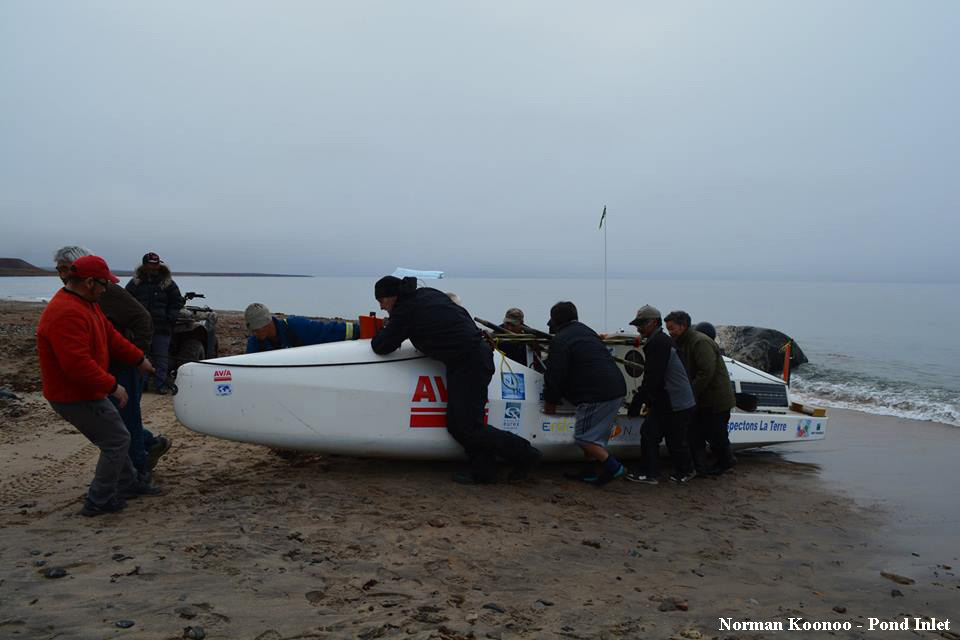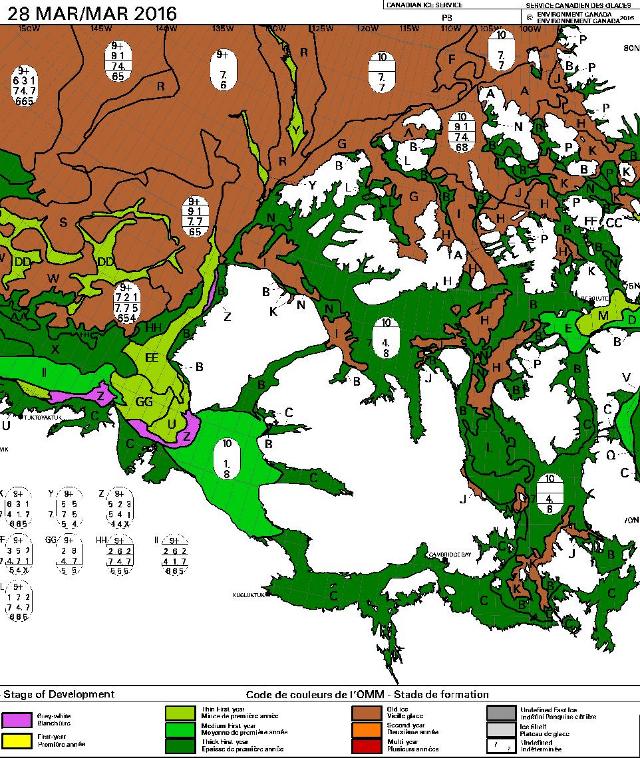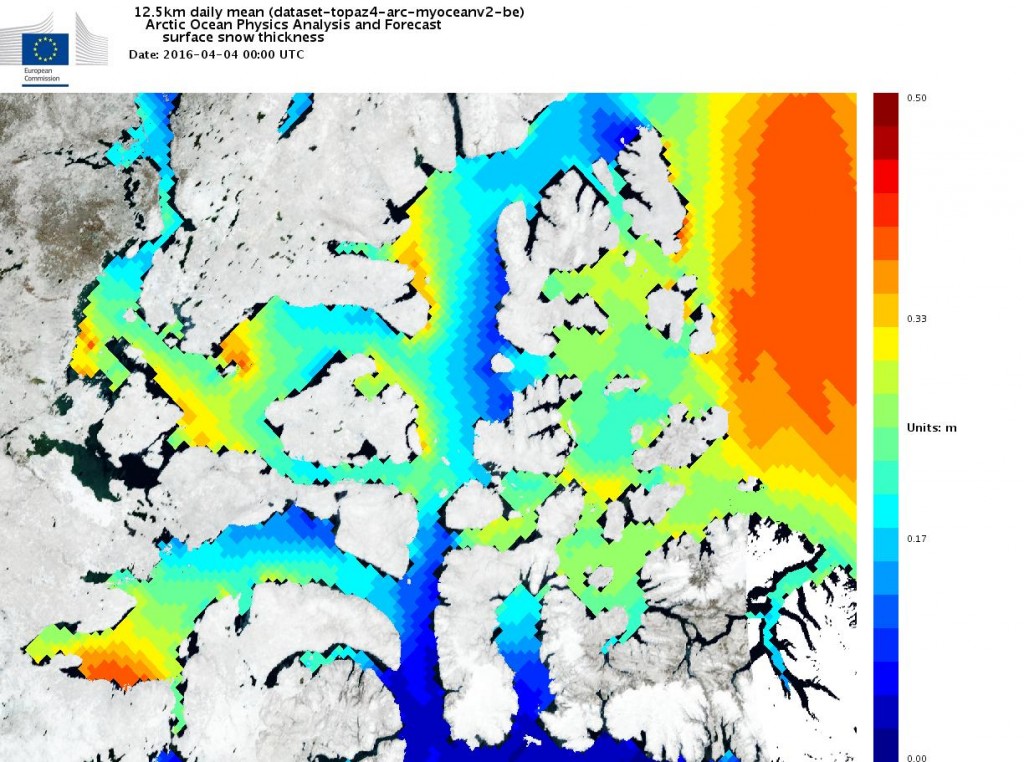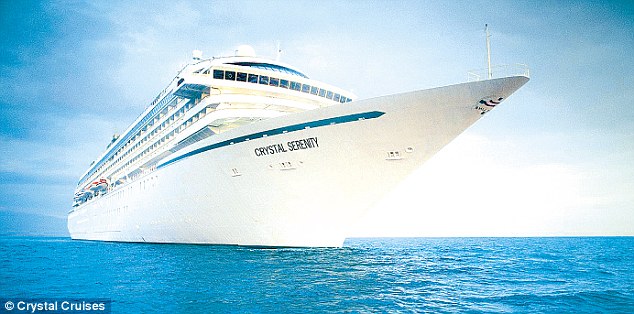Our coverage of the Northwest Passage is starting somewhat earlier then usual in 2016. That’s because an educational comment of mine seems to have gone permanently missing over at Andrew Montford’s blog. Over there commenter “Golf Charlie” suggested that:
Perhaps based on rumours, or folk stories, the possibility of a North West Passage, was the answer to many peoples dreams of wealth, fame and fortune. The Franklin Expedition set off, with all confidence, knowing that there had been an unprecedented retreat in Arctic sea ice extent. They never came home. The ships then sent to rescue them, never came home either, but some survivors did.
In July 2010, due to unprecedented ice loss, a team set out to find HMS Investigator, (one of the rescue ships) and found her within 15 minutes, exactly where she was trapped and abandoned. How had she got there?
This may be just a load of boring and irrelevant history to you, but as an ice expert keen to lecture others, it just seems strange that you don’t acknowledge the fact that before man made CO2 emissions could possibly had any remote chance of shrinking sea ice, it had all happened before.
It is likely that whatever caused the ice to retreat in the 1830s/40s, may have caused the current retreat. As no attempt has been made to explain this historical retreat, it seems premature to jump to conclusions about the present. What stories and folklore convinced Franklin there was a NWP? Had it opened before? Did the Vikings circumnavigate the North Pole? No one knows for sure.
Here’s the beginnings of my by now expanded reply:
I am already very familiar with the sorry tale of Franklin’s ill fated expedition. By way of some more recent Northwest Passage history, were you previously aware that Charles Hedrich completed his own multi-year voyage through the NWP last summer? His vessel was much smaller than Franklin’s:
“He is now, the first man to have rowed solo the North-West Passage.”
It’s not terribly clear, but apparently Charlie thinks his “unprecedented ice loss” in the Summer of 2010 had a precedent in the 1840s and/or 50s. Perhaps he will pop in and elucidate? Whilst we wait to see what transpires in that regard, here’s an animation of sea ice concentration across the Northwest Passage last summer:
You will note that the “southern route” taken by Roald Amundsen in Gjøa opens first, ultimately followed by the “main route” via the McClure Strait.
My missing comment also referenced (by way of example!) a 2015 academic journal paper entitled “Ice thickness in the Northwest Passage“. Amongst its other conclusions can be found this:
Global climate models with their coarse resolution likely have difficulty capturing intricate sea ice dynamic processes within the narrow channels of the CAA. Specifically, the import, survival, and thickness of MYI are difficult to predict and may in fact increase during the transition to a sea ice-free Arctic with more mobile ice conditions in the Queen Elizabeth Islands which are located between the Arctic Ocean and NWP. Presumably, MYI from the Arctic Ocean will be more heavily ridged and thicker than locally formed MYI, posing greater danger to transiting ships than locally grown MYI.
Whilst we look forward to the prospects of the “transition to a sea ice-free Arctic”, what about the prospects for the Northwest Passage in the summer of 2016. As you can see from the video there wasn’t much in the way of multi-year sea ice left there by the Autumn of 2015, and there doesn’t seem to have been much transport of ice into the Canadian Arctic Archipelago over the winter either.
On top of the ice there will of course be some snow by now. Here’s how the Topaz 4 snow cover map of the area looks at the moment:
All in all it looks to me at this early stage of the 2016 Arctic sea ice melting season as though one or more of the assorted routes through the Northwest Passage will be open again this coming summer. Do you suppose that will look like yet another “unprecedented retreat” to “Golf Charlie’s” eyes?
It seems as though a large commercial organisation sees things that way too. Crystal Cruises have concluded that in 2016 the Northwest Passage offers:
The ultimate expedition for the true explorer!
Anchorage to New York on Crystal Serenity
DATES : August 16 – September 17, 2016 (32 Days) CRUISE-ONLY FARES FROM : $21,855 Per PersonMore than 18 months of careful planning and analysis has already gone into this project from January 2013 to July 2014, and will continue up to, and through, departure.
There will not be shore-based cell phone signals along the transit, except in the communities and towns we will be visiting. However, guests are requested to not use this signal when in port, as it will overwhelm the local system and disrupt the communication within the community.
While communication channels may be temporarily limited or unavailable to guests, the ship’s Captain and crew will always have operational and emergency communication throughout the entire voyage.




Ah, for just one time I would take the Northwest Passage
To find the hand of Franklin reaching for the Beaufort Sea…
[Thanks Layzej – I’ve taken the liberty of embedding your most excellent vid – Jim]
[2019-03-25 – The original live recording of Stan Rogers seems to have gone missing – I’ve taken the liberty of adding a couple of others – Jim]
I love the song and the performance – the Northwest Passage.
I can’t even imagine what a kind of journey they had.
“In 1849 Robert McClure passed through the Bering Strait with the intent of sailing through to the Atlantic. His ship was trapped in the ice not far from making it to Viscount Melville Sound and probable passage to the Atlantic. Finally, after spending three winters on the ice and dying of starvation, McClure and crew were rescued by a sledge party from one of Sir Edward Belcher’s ships and transported by sledge to the Sound. McClure and his crew became the first to survive a trip through the Northwest Passage”.
Of course, in the finest traditions of the Royal Navy, the first thing Robert McClure (or M’Clure) had to do upon his return to Blighty, was to face court martial for having “misplaced” HMS Investigator.
Fans of the BBC sitcom “Dad’s Army” may care to check out his middle name.
Well you learn something new every day. Sometimes even two things. Thanks Bill.
I seem to be in a musical mood today, so here’s a “Southwest Passage” sea shanty of a sort:
An extended article in Outpost Magazine. Kevin Vallely et al. investigate the secrets of Franklin’s famed doomed voyage:
Here’s an associated video:
I recently read a book on the Tambora eruption, and in it it mentioned, amongst all the other effects, the counter intuitive idea that the Arctic might have experienced several very low ice years- I don’t think he mechanism was well described- just prior to the Franklin expedition. I pass no judgment on the theory, however, this may be the origin of the posting referencing Franklin’s expectations of a lower concentration than he found.
Hi Sebastian,
I’m familiar with the suggestion that the Tambora eruption caused the “Year without a summer” in 1816, but not that it in some way affected the Arctic decades later.
I don’t suppose you have a link to the book you refer to do you?
The Tambora eruption has been identified as a cause for a period of relatively warmth in the Arctic from 1815 to 1818. The mechanism was identified as a consequence of the Mt Pinatubo eruption in 1991. An explanation is provided here:
http://theconversation.com/largest-volcanic-eruption-in-human-history-changed-the-19th-century-as-much-as-napoleon-25098
This led many to falsely beleive in the possibility of an open NWP for many decades.
Thanks very much David – I learned this today:
I’ve issued another invitation for “Golf Charlie”, “Radical Rodent” et al. to pop in here and justify their “unprecedented retreat in Arctic sea ice extent [in 1845]” assertions:
They and their “evidence” are still conspicuous only by their absence, so the question still remains:
Were I a betting man I’d wager that the captain of Crystal Serenity wouldn’t have fancied his chances were he and his shipload of paying passengers to find themselves magically transported back in time.
Their cell phones wouldn’t have worked back then either.
The North West Passage which stands out for me in 2015 is MV Andros which went west to east along the southern route to Greenland and then turned round and went back to Seattle along the aptly named “route 1” through McClure strait in the same season. Route 1 is the one which looks really obvious when you look at a map, but usually has been blocked by ice.
A very detailed description(and some historical asides) can be found here http://northwestpassage2015.blogspot.co.uk/2015/10/week-14-can-mv-andros-complete.html?view=timeslide
I think you will find that Doug Pohl managed to pull the wool over your eyes last year Andreas. See:
https://GreatWhiteCon.info/2015/08/is-the-northwest-passage-open-yet/#comment-212123
I must admit I was fooled at first too. It would be interesting to discover how he managed to get the position of Andros onto an apparently automatically updated map of the NWP. Nevertheless a fair few small boats did manage to make it through quite legitimately!
That would explain why none of the other boats ever mentioned meeting MV Andros.
But doesn’t it still mean that the trip would have been possible, he documented the conditions which the Andros would have experienced quite well, I think.
It might have been possible if someone with a real yacht was willing to take the real risk in real life. David Scott Cowper might be the man for the job? He has at least sailed MV Polar Bound past Mercy Bay in real life in the not too distant past:
I guess Doug made his point well though? There’s no way anybody could have contemplated such a journey in the mid 1800s!
Stop Press!
David Scott Cowper and Polar Bound actually went and did it:
“David Scott Cowper Makes History – Again”
Crystal Cruises have announced in a press release:
If everything goes according to plan the Crystal Cruises flotilla may bump into (hopefully only metaphorically!) another cruise ship in the Northwest Passage this summer. According to Hapag-Lloyd Cruises you could:
Comparing modern high tech stunts like rowing with the Franklin expedition is more than a bit silly. Or choosing modern power ships, with satellite navigation and constant communication making specialty rich tourist trips as a proxy for Victorian era exploration is equally fraught with inconsistencies.
Also, the paleo evidence for dynamic Arctic ice pack goes back much farther than the 19th century.
By the way, the risks of polar sea ice have been frequently under estimated. Especially by famous climate scientists:
https://climateaudit.org/2014/01/15/ship-of-fools/
Hunter – Fraught with inconsistencies perhaps, but are you seriously suggesting that the might of the Royal Navy failed in the 1840s in similar ice conditions to those in which Charles Hedrich succeeded in the 2010s?
As for the risks of polar sea ice, no doubt we all await with interest the procession of vessels large and small attempting to make their way through the Northwest Passage this coming summer.
looks like this could be a record low ice year